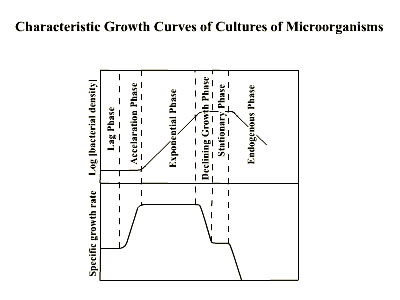When a small number of viable bacterial cells are placed in a close vessel containing excessive food supply in a suitable environment, conditions are established in which unrestricted growth takes place. However, growth of an organism do not go on indefinitely, and after a characteristic size is reached, the cell divides due to hereditary and internal limitations. The growth rate may follow a pattern similar to as shown in figure:

The curve shown may be divided into six well defined phases:
- Lag Phase:adaptation to new environment, long generation time and null growth rate.
- Accelaration phase: decreasing generation time and increasing growth rate.
- Exponential phase: minimal and constant generation time, maximal and constant specific growth rate and maximum rate of substrate conversion.
- Declining growth phase: increasing generation time and decreasing specific growth rate due to gradual decrease in substrate concentration and increased accumulation of toxic metabolites.
- Stationary phase: exaustion of nutrients, high concentration of toxic metabolites, and cells in a state of suspended animation.
- Endogenous phase: endogenous metabolism, high death rate and cell lysis.
The most widely used expression for the growth rate of micro organisms is given by Monod:
Total rate of microbial growth,dx = mmXS
dt Ks+ S
where,
mm= maximum specific growth rate
X = micro organism concentration
S = substrate concentration
Ks= substrate concentration at one half the maximum growth rate
Similarly, rate of substrate utilization,
dS = k X S
dt Ks+ S
where,
k = maximum specific substrate utilization rate
Maintenance as Endogenous Respiration
Net growth rate of micro organisms is computed by subtracting from the total growth rate, the rate of micro organisms endogenously decayed to satisfy maintenance energy requirement. Therefore,
Net rate of microbial growth = mmX S - kdX
Ks+ S
where,
kd = endogenous decay coefficient
Growth Yield
Growth yield is defined as the incremental increase in biomass which results from the utilization of the incremental amount of substrate. The maximum specific growth rate is given by: mm =Y.k
where, Y is the maximum yield coefficient and is defined as the ratio of maximum mass of cells formed to the mass of substrate utilized. The coefficients Y, kd, k and Ks are designated as kinetic coefficients. The values of kinetic coefficients depend upon the nature of wastewater and operational and environmental conditions in biological reactor. The biological reactors can be completely mixed flow or plug flow reactor with or without recycle.
.